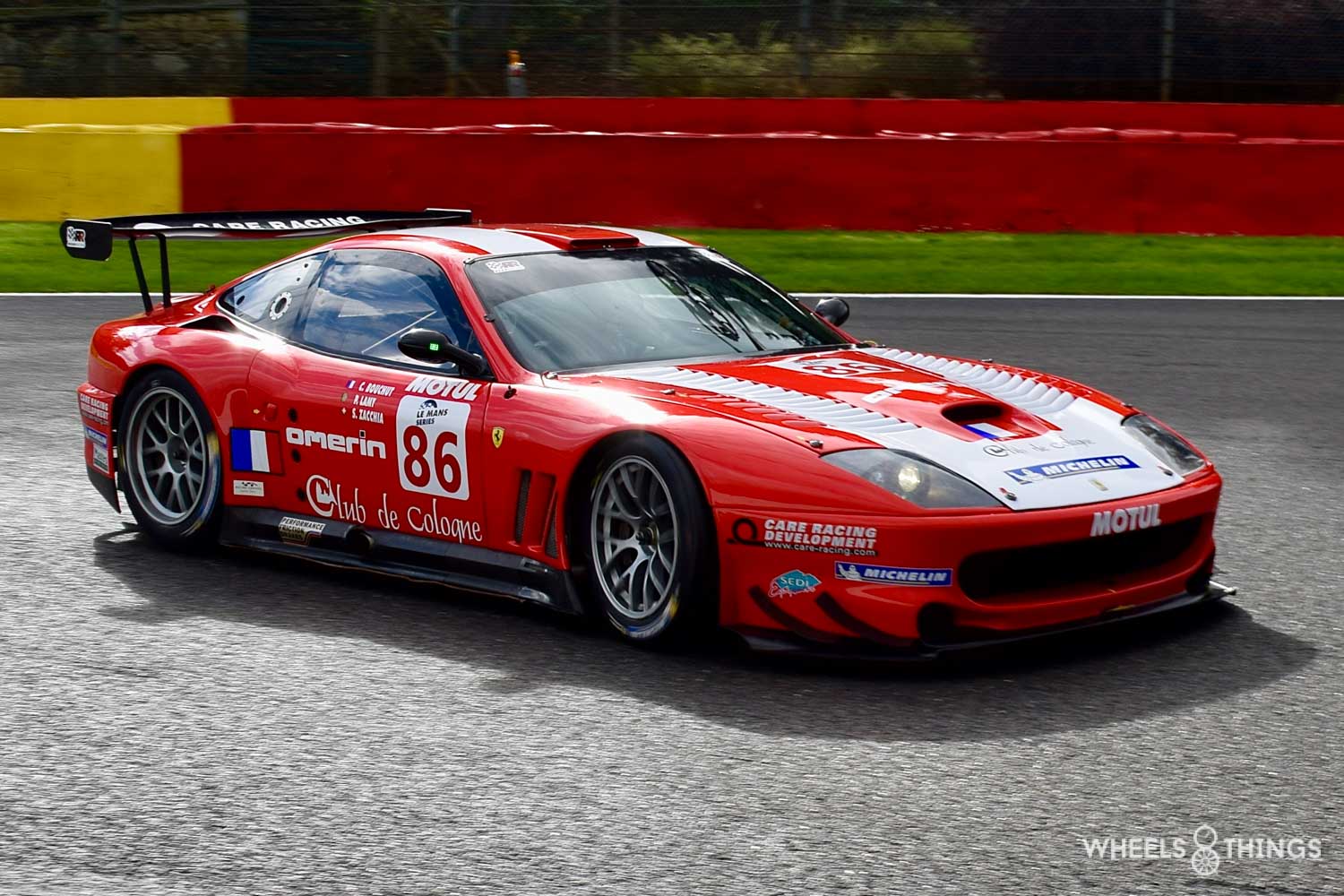
We already told you in our general report on Rétromobile: 2024 was another top edition with the most beautiful classic cars. Besides all the beauty you have already been able to get to know by now, we have kept some of them separate. We still owe you the ten most beautiful, unique or spectacular racing cars. We take you for a second time through the halls of Rétromobile for ten more gems.
1. LIGIER JS 2 1973
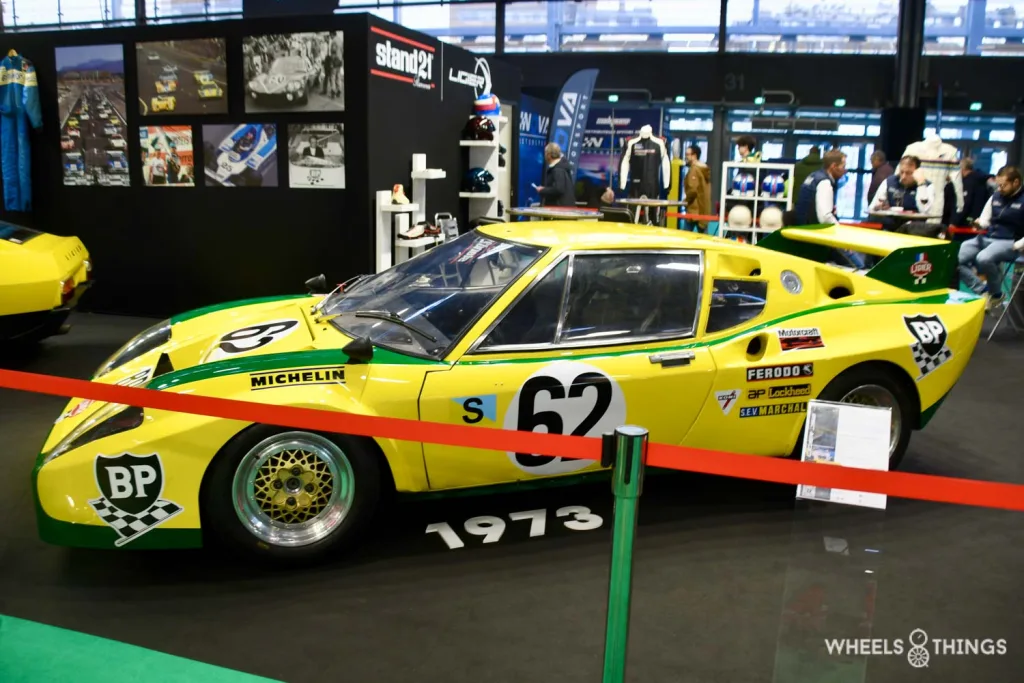
We are in France and so we start with a French creation: a Ligier JS 2. Ligier? You may have already driven behind it. One of those mopeds, fitted with a max 45km sign at the back. That is indeed a current Ligier. Ligier used to be a French car brand that built sports cars and even had a Formula 1 racing stable.
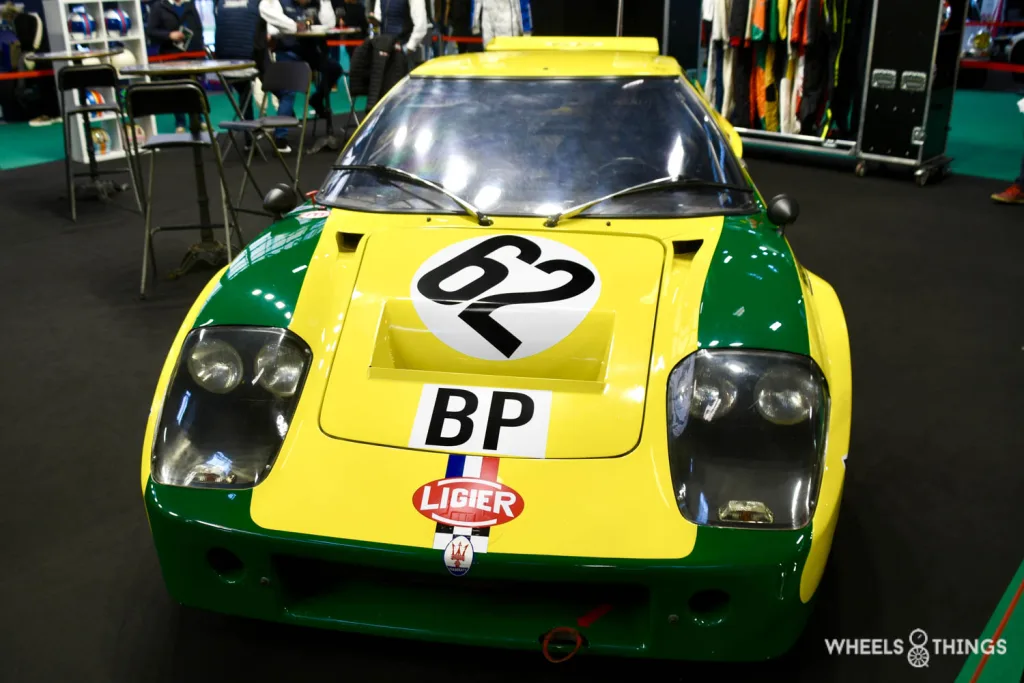
Guy Ligier, after a rowing and rugby career, becomes a car pilot. He is quite good at it and is hired by Ford France for their official programme. He drives several cars such as a Mustang and the GT40. Guy even gets into Formula 1, as a pilot. He started in 13 GPs with sixth place as his best result. Ligier usually formed a team with his friend Jo Schlesser. The latter sadly died during his F1 debut in the French Grand Prix. Ligier is so impressed that he immediately stops racing. He founds “Ligier Cars” and starts building his first sports car: the JS 1. Three were built, followed immediately by this JS 2. The initials JS stand for Jo Schlesser. The JS 2 is a two-seat sports car fitted with a V6 Maserati engine. The bodywork comes from Pietro Frua. Ligier builds just over 200 units of this JS 2, with the then bankruptcy of Maserati bringing an early end to production.
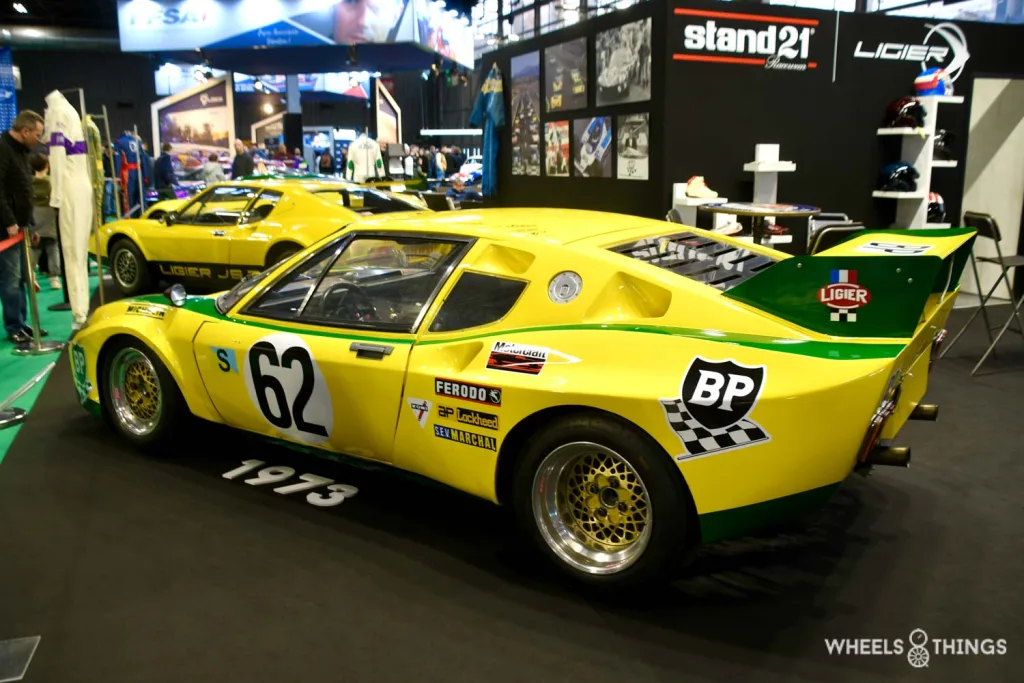
And, of course, there is also a sports programme for this JS 2. In 1972, it competes in the 24 hours of Le Mans but the Maserati engines don’t last. The following year, this yellow JS2 starts with BP sponsorship. Guy Ligier is back at the wheel but again he and colleague Jacques Lafitte have to retire with a faulty engine. In the Tour de France, this JS 2 is on its way to victory. Gérard Larrousse wins 14 out of 17 stages until a faulty power distributor throws a spanner in the works. In 1974, there is a win in the 4 Hours of Le Mans and an eighth-place finish in the 24 Hours of Le Mans. The biggest success comes a year later with a second place in the 24 hours of Le Mans. Meanwhile, the JS 2 is fitted with a V8 Ford Cosworth engine and Jean Louis Lafosse and Guy Chasseuil are long in a fierce battle for victory with the Gulf Mirage of Jacky Ickx and Derek Bell. This is the last race for this JS 2. Ligier, as a team, makes the move to Formula 1 and debuts in early 1975 with its JS 5 fitted with a Matra V 12 engine in the Argentina Grand Prix.
2. FERRARI 312 B 3-74 1974

Ferrari obviously cannot be missing from this series but which one? The selection was again very large but we chose this 1974 312 B3 first. Ferrari was in a slump in the early 1970s. The programmes in F1 and the World Endurance Championship were not really going as planned. The endurance programme was scrapped at the end of 1973 and all attention would go to F1. Due to the poor results, Jacky Ickx and Artureo Merzario had left and Enzo had to look for new drivers.
He ended up with Clay Regazzoni who came over from BRM. Regazzoni had previously been a Ferrari pilot. He convinces Enzo to hire the still young Niki Lauda as well. Ferrari, through Lauda’s input, would once again become a top team. But this did not go smoothly. The 312 B3 is very fast though, with 10 pole positions out of 15 races, as proof. But reliability is not yet in post in 1974. Still, three races are won. Two for Lauda ( Spain and the Netherlands ) and Regazzoni wins the German GP at the Nürburgring.
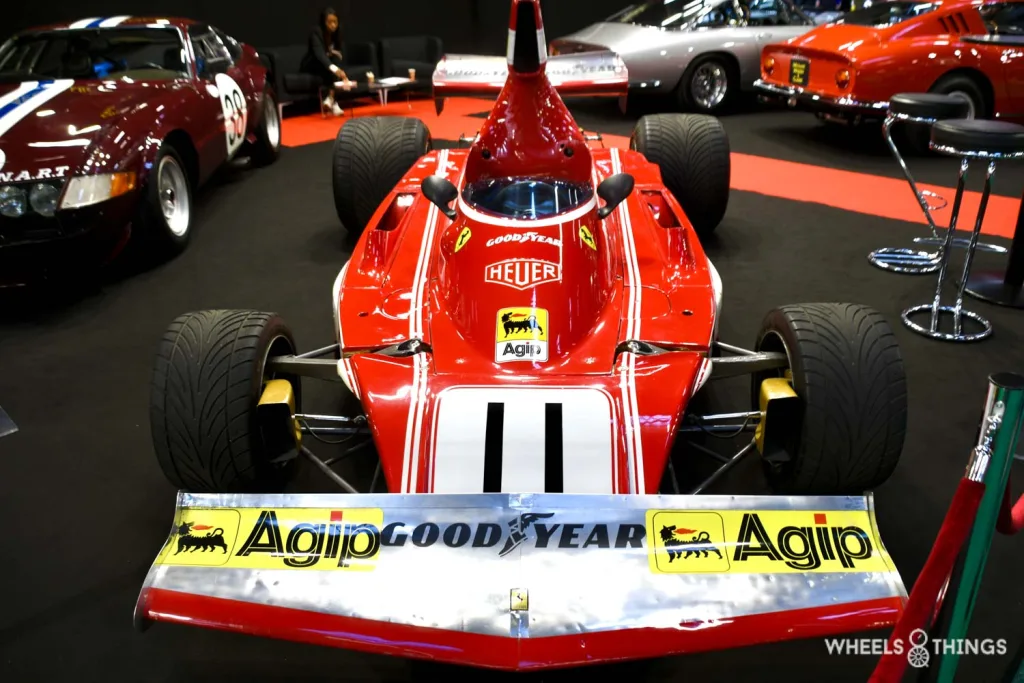
Regazzoni, notwithstanding all the technical problems, does remain in the running for the world title. This will only be decided in the very last race with a real championship decider. He and Emerson Fittipaldi start the GP of the Americas at Watkins Glen near New York with equal points. In qualifying, they are P8 and P9 together. Things could not get any more exciting. Regazzoni struggles with the handling of his Ferrari throughout the race. He even makes a pit stop for new tyres and that was an exception back then. Fittipaldi climbs to P4 and becomes the 1974 world champion. He wins his second title and the first for Mclaren. But the foundations for Ferrari were laid and in 1975 the successor ( 312 T ), with Niki Lauda at the wheel, became another World Championship-winning car.
3. FERRARI 312 PB

The car that had to make way for this success was also in Paris. Clockmaker Richard Mille had again provided a fine collection of Ferraris in his traditional expo. This 312 PB, with chassis number 0890, saw the light of day in late 1971. In 1972, it was driven by Ickx, Merzario, Redman and Regazzoni. A win in the 1000 km of Francorchamps is its best result.
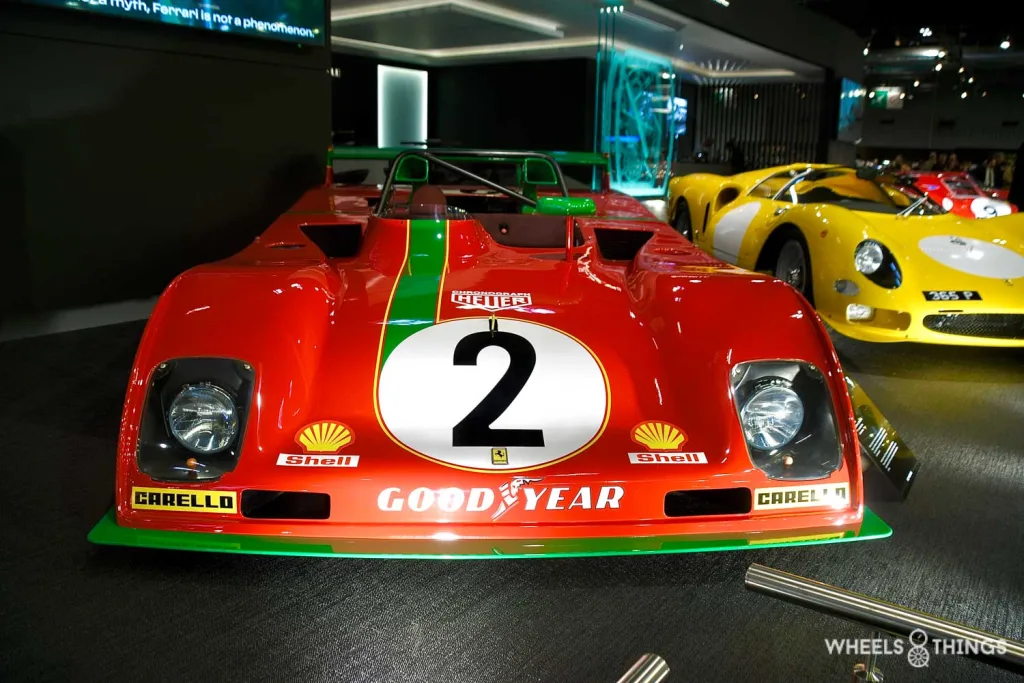
For the 1973 season, it gets an update with a new bodywork and a V12 engine that by now delivers 500 HP. It becomes the service car for Artureo Merzario and Carlos Pace. 0890 gets the green stripes on its bodywork. Ickx and Redman drove with the yellow as it is again the case now in the WEC. For the World Championship, Ferrari is in contention with Matra. The French take the title with five wins vs one for Ferrari. Ickx and Redman win the 1000km of the Nürburgring. 0890 cannot win a race but does provide some nice points. Three fourth-place finishes at Vallelunga, Dijon and Francorchamps. A third place at Watkins Glen and two second places at the Nürburgring and the 24 hours of Le Mans.

In the final standings, however, Ferrari falls nine points short of the world title. Enzo decides, in late 1973, to discontinue the programme. Fifty years later, it is restarted and Ferrari, with its new 499 P, wins the centenary race of the 24 hours of Le Mans.
4. BENTLEY SPEED 8

Following VW’s takeover of Bentley, the Crewe-based marque wants to take part in the 24 Hours of Le Mans again. Parent company VW can already provide the necessary technology through Audi and the “Bentley Boys” can head towards Le Mans again, after their previous successful participations in the 1930s.

The development of the new Bentley Speed 8 is launched in September 1998. It is a collaboration between the British team and the German division of Audi Sport, which supplies the mechanical parts of their Le Mans R8 winning model. The chassis comes from at RTN. Two years later, the first Speed 8 is presented during a presentation at the Bentley factory in Crewe. After a lot of testing, a first start is made in the 24 Hours of Le Mans in June 2001. Both Bentley’s run in the LMGTP class. Start number 8 with Andy Wallace, Butch Leitzinger and our Eric Van de Poele finish on the podium in third place.
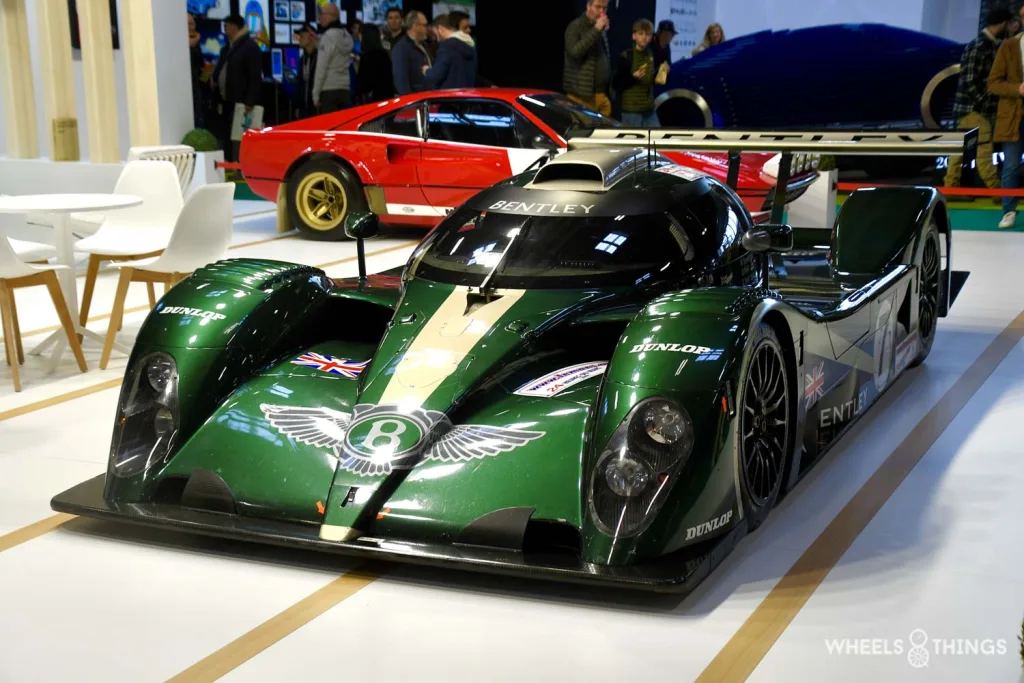
The other Bentley with start number 7 had to leave the race on Saturday night after an incipient fire from a blocking gearshift mechanism. Only one will start at Le Mans in 2002. Start number 8, with the same crew as in 2001, now falls just short of the podium with fourth place. The testing years are over and Bentley will return for the win in 2003. This succeeds and once again the Bentley boys are on the top step of the podium. The drivers came from Audi this time and Rinaldo Capello, Tom Kristensen and Guy Smith ( there was also to be a pilot from the UK ) finish 2 laps ahead of their colleagues Mark Blundell, David Brabham and Johnny Herbert.
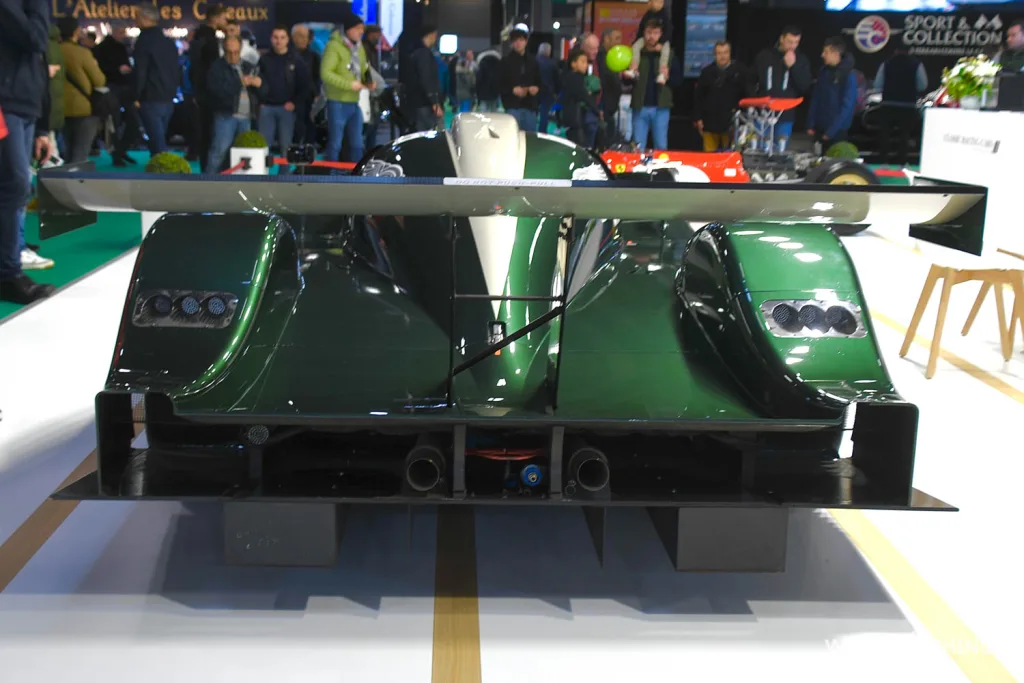
Six examples of this first version of the Speed 8 ( code 002 ) were built. One of these was on display at Retromobile. This 002 version only contested two races and will be replaced from 2003 by an evolved version given code 004. This version will provide the big success at Le Mans in 2003. Chassis number 004/1 competes regularly in the Endurence Racing Legends Series. We already saw it a few times at the Francorchamps circuit.
5. BRABHAM BT 26 A
This Brabham Formula 1 car was designed by Ron Tauranac. This later built his own cars ( mainly Formula 2 and 3 ) under the name Ralt. In 1968, this BT 26 was fitted with a Repco engine. This engine is not very reliable and Jack Brabham and Jochen Rindt, in all but one race, drop out.
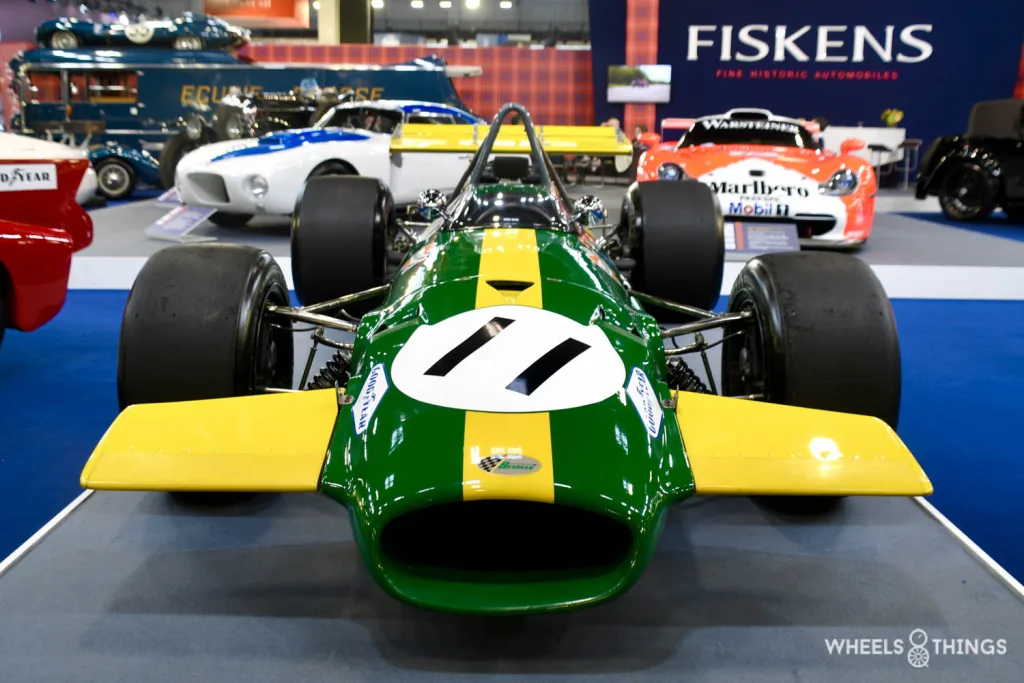
The car used by Jochen Rindt will be rebuilt over the winter. The Repco engine disappears and is replaced by a Ford Corworth. Rindt leaves for Lotus and is replaced by young Belgian talent Jacky Ickx.
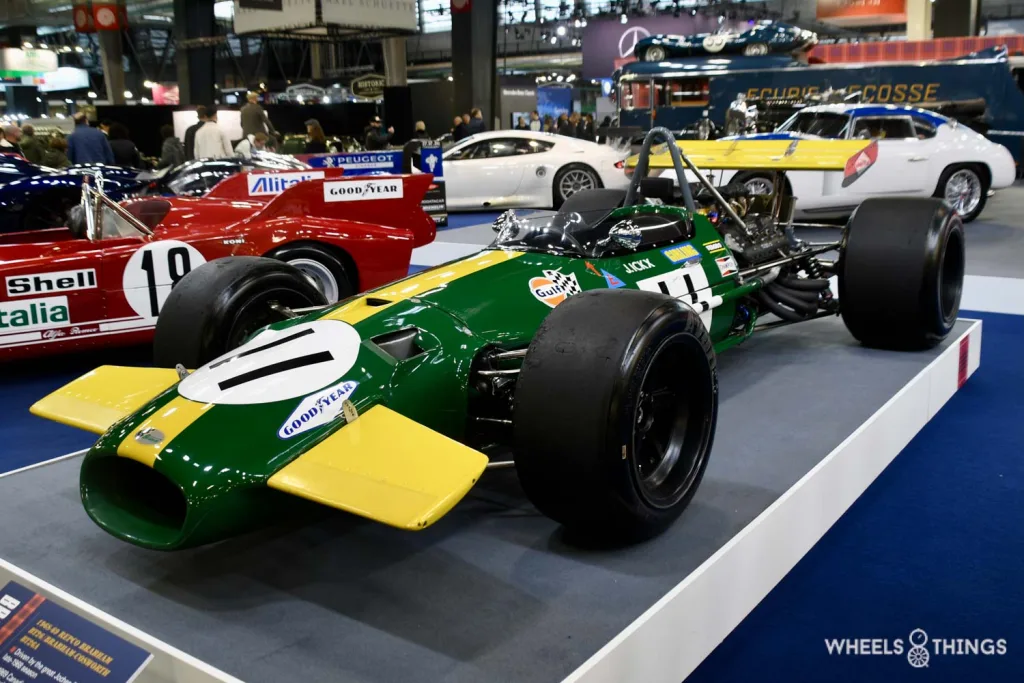
Ickx makes a fresh start at Brabham. He wins the GPs of Germany ( at the old Nürburgring ) and Canada. He is the only one to try any resistance to the supremacy of Jacky Stewart and his Matra of the Tyrrell team. He also becomes the 1969 vice-world champion behind Stewart. This gets him a contract from Enzo Ferrari. He will stay with the Italian racing stable for three years. His final year includes driving the aforementioned 312 PB in the World Endurance Championship.
6. ALFA ROMEO 33 TT 3/ 33
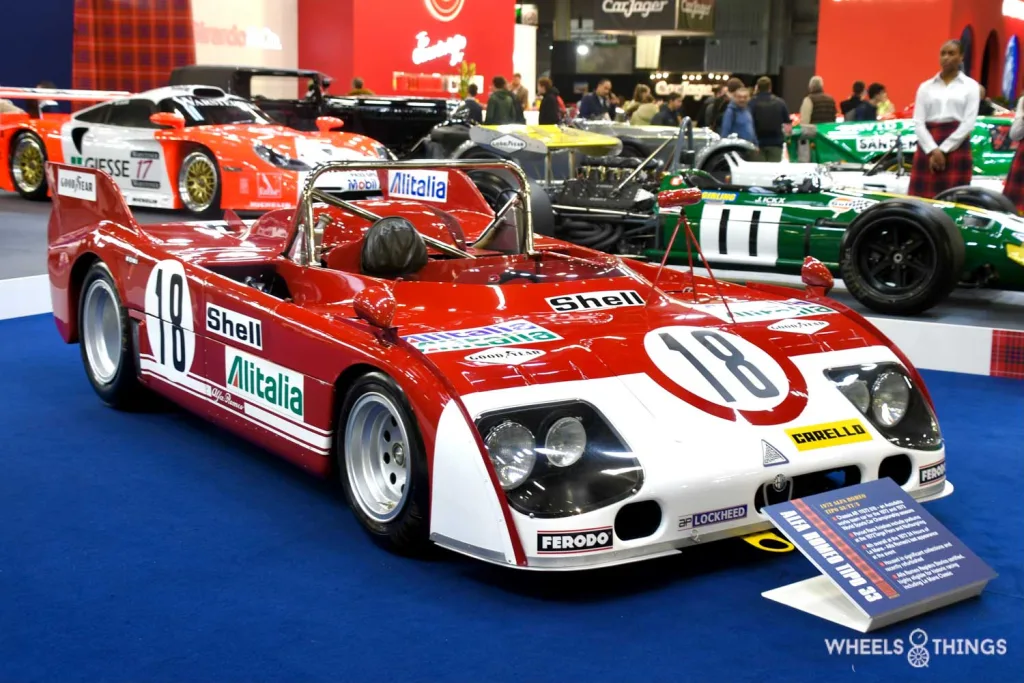
At Fiskens, we found this Alfa Romeo 33 TT 3. Chassis number AR 11572 010 was used by the official Alfa Autodelta team during the 1972 season. Regular pilot Andrea De Adamich was assisted during that year by several co-drivers such as Galli, Elford, Hezemans and Vacarella. Current Red Bull consultant Helmut Marko also took part in the 1000 km of the Nürburgring with it, and together with De Adamich, with a third place, ensured the best result of 1972.

This 33 TT 3, fitted with an eight-cylinder Alfa engine, will probably only have a very short racing career. Its last race was back in June 1972. The Adamich and Vacacarelle provide a nice farewell with a fourth place in the 24 hours of Le Mans. It is also the last Alfa Romeo ever to compete in the 24 hours of Le Mans
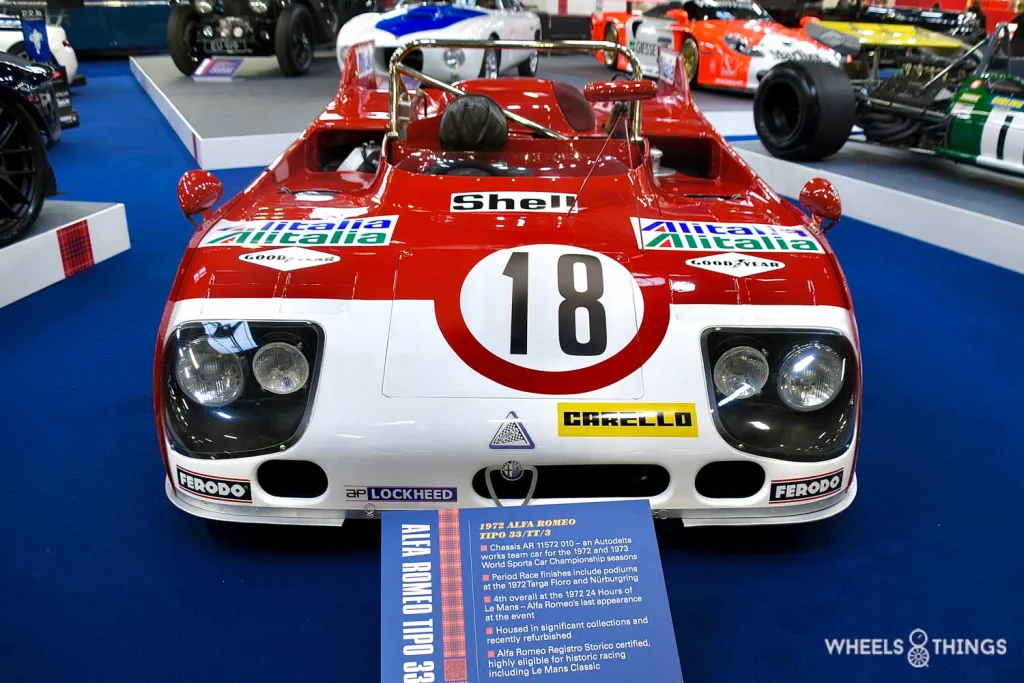
7. ALFA ROMEO 33 TT 12

At auction house Artcurial, we found the successor to this 33 TT3 with the 33 TT 12. The Alfa was fitted with a 12-cylinder engine from 1973. Chassis number AR 115 12 0011 was offered at their annual Rétromobile auction.
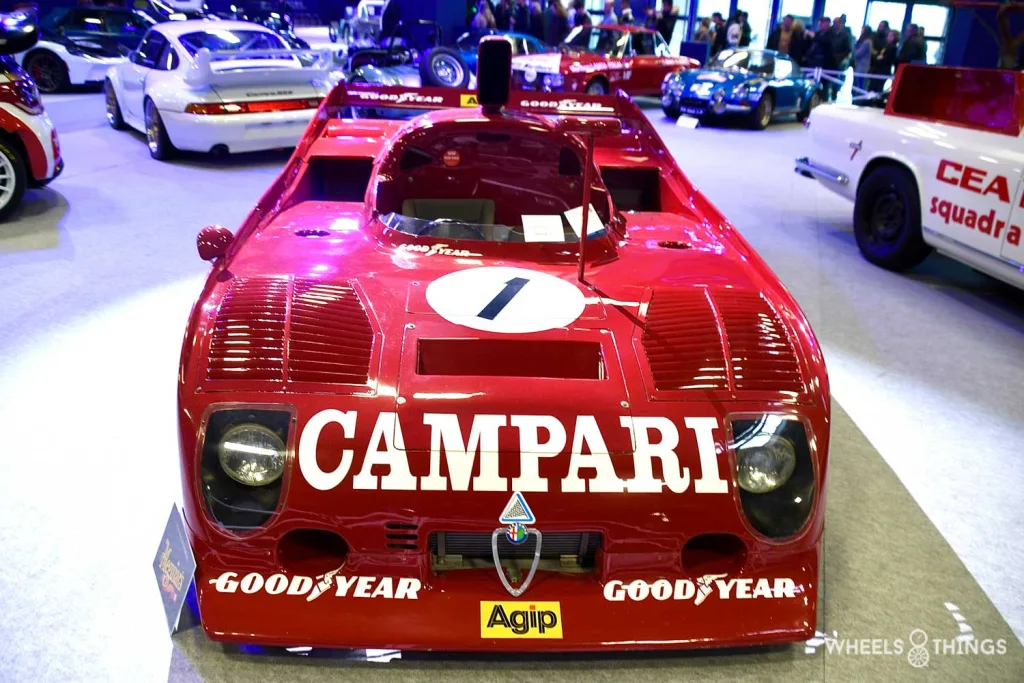
This 33 TT 12 was built in 1975 and used by the private Willy Kaushen Racing Team in the 1975 World Championship. The WKRT team gets access to 4 examples of this TT 12 and this 0011 was used as a test car. It does take part in some races in the Interseries Championship. Later, a Formula 1 test engine will be fitted at Bernie Ecclestone’s request. This will also be used in his Brabhams from 1976. Bernie switched from Ford Cosworth ( paying engines ) to Alfa Romeo ( free engines ). WKRT’s other 33 TT 12s win the world endurance marque title for Alfa in 1975 with Jacky Ickx, Derek Bell, Henri Pescarolo and Artureo Merzario. The Alfa did not find a new owner.
8. FERRARI MANARELLO 550 PRODRIVE GT1
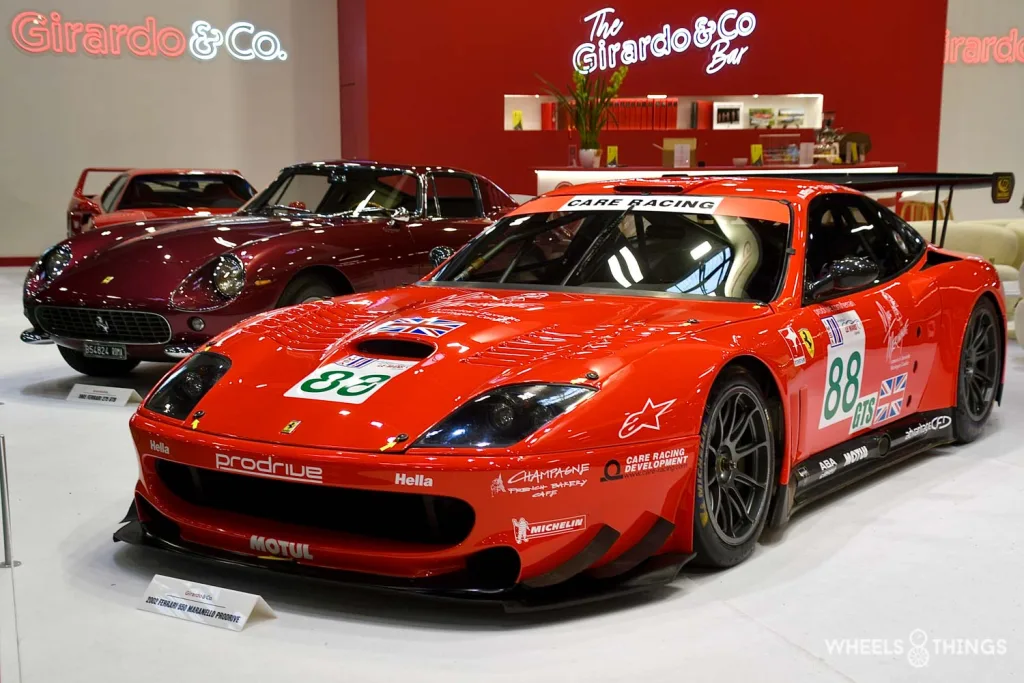
Another Ferrari with this stunning 2002 Maranello Prodrive GT1. This 550 “Made in England” was offered for sale by Girardo & Co. Made in England? Most definitely because this Ferrari comes from Prodrive’s workshops and was developed and built by David Richards’ team without Ferrari’s cooperation. In fact, Ferrari was so opposed to this project that it did not want to supply bare coachwork to David Richards’ team. They had to turn to the used car market and bought usable street cars that were then completely scrapped. This also happened to this ZFFZR49B000108612 that would be converted to CRD 05/2002. CRD stands for Car Racing Development, the firm of Frédéric Dor who took care of the financial side of the programme.

Prodrive delivers a stunning GT1. The Ferrari makes its debut in mid-2001 in the FIA GT championship in Budapest. But due to various teething problems, abandonment follows. The 24 hours of Spa are not contested but in the next race at the A1 Ring in Austria it is already a prize. Richard Rydell and Peter Kox provide the first success. They repeat this later at Jarama.

2002 sees a first foray into Le Mans with one car. Thomas Enge puts the 550 Maranello on pole. Halfway through the race, the Ferrari leads by 3 laps ahead of the fastest Corvette. A broken oil pipe causes an incipient fire and Alain Menu has to abandon the car along the circuit. In 2003, this CRD 05 joins the team. The first race is the 12 hours of Sebring in Florida. Darren Turner, Anthony Davidson and Kelvin Burt finish P2 in the GTS series after the Corvette of Fellows, Fréon and O’ Connell.
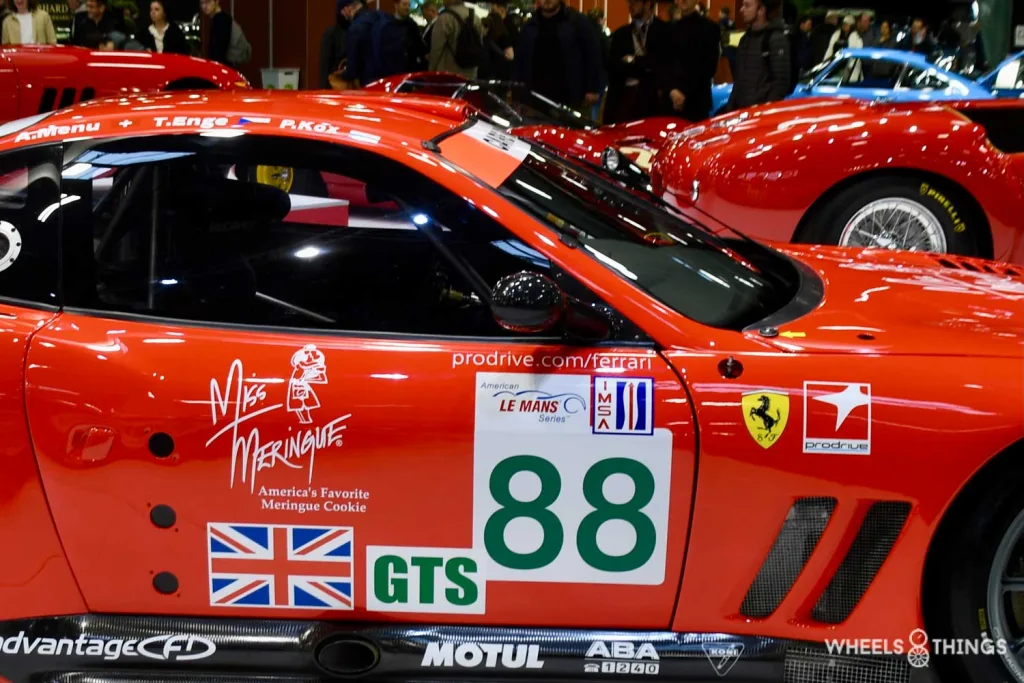
At Le Mans there is another pole for teammates Kox, Enge and Davies. CRD 05 with the same crew as in Sebring gets to start second. The Prodrive Ferraris are 6 seconds faster on one lap of Le Mans against last year. Both Ferraris drive continuously at the head of the GTS class. After 5 hours of racing, CDR 05 even takes the lead. They later relinquish this again to their teammates. They do continue to drive around in second place until a little after halfway through the race Anthony Davidson parks the Ferrari in the crash barriers at Mulsanne. The impact is quite severe and the pilot is taken to hospital for a medical check-up for safety reasons.

Teammates Peter Kox, Thomas Enge and Jamie Davies ensure a historic win in the GTS class. They won by 10 laps ahead of the second Chevrolet Corvette and ensured a new and long-awaited win by a Ferrari 12-cylinder engine. This Maranello with start number 88 was on display at Rétromobile one stand over from Richard Mille’s neighbours in the Ferrari expo.

CDR 05 makes a third trip to the Road Atlanta circuit for the Petit Le Mans race. There is a driver change, though. This time, Le Mans winners Peter Kox and Thomas Enge are at the wheel. They are assisted by Alain Menu. The Ferrari now proudly wears the Le Mans car’s winning number 88. And this time it does win. CDR 05 wins its first race in a fierce duel with team colleagues. 88 finishes one second ahead of 80 after ten hours of racing.


After his year as official Prodrive car, CDR 05 leaves for France and joins the Larbre team. Jack Leconte and his team were the reference in FIA GT for many years with their top Vipers and very successful. This will not change with the Prodrive Ferrari. They participate in the new LMES ( Le Mans Endurance Series ) and the French GT championship. In the LMES, however, they are clashing with opposition. Meanwhile, Ferrari has created its own with the latest 575 GTC Maranello. But this official creation cannot make a fist against the old Ferrari from the UK. Larbre’s private team, with Bouchut/Lamy and Zacchia, wins all four championship races at Monza, Silverstone, Spa and the Nürburgring. In the 24 hours of Le Mans, they finish fifth in the GTS class. In the French GT championship, they achieve second place in the final standings. We saw the car at Spa in 2019 in its Labre version during the Endurence Legends series. In 2005, there is a third participation in the 24 Hours of Le Mans with a fourth place in the GTS classification. After that, the car continues to be used successfully on a regular basis in the French GT championship. CDR 05 achieves 7 victories and 20 podium finishes and finished in 96% of the races it participated in.
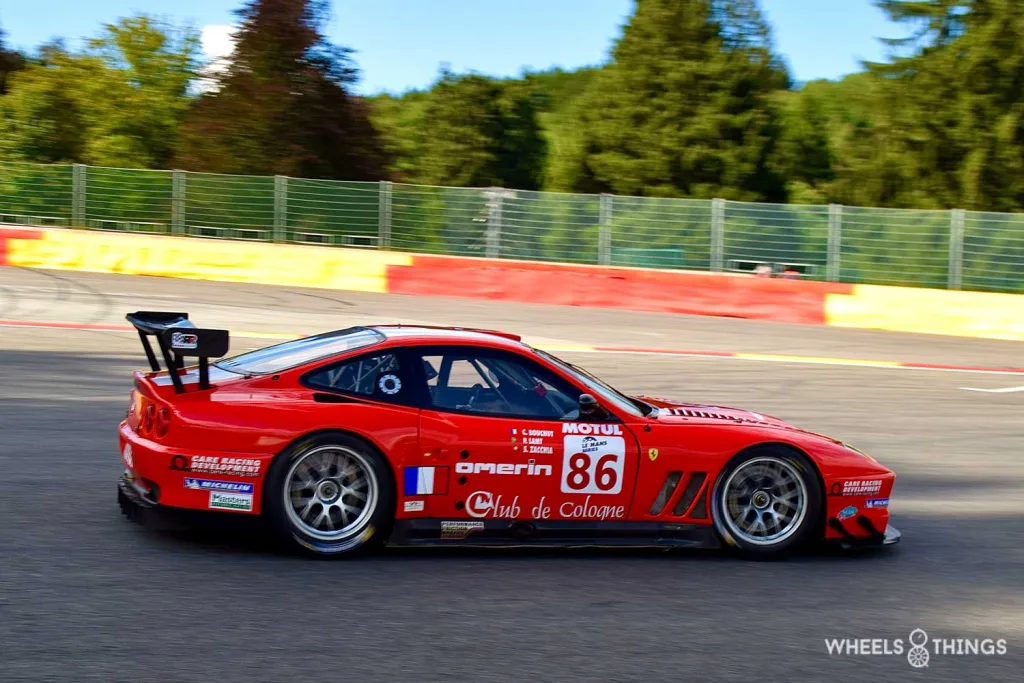
Prodrive built 10 and this CDR 05 is one of the five used by the official team. The car, meanwhile, was restored and returned to its winning version of the 2003 Petit Le Mans race. This Prodrive Ferrari chapter came to an end when Aston Martin thought: we can do the same with our DB9. They commissioned Dave Ricards’ team to make a similar creation of their DB9. This Prodrive DB9R GT1 will be its successor and Prodrive will become Aston Martin’s official factory team. The successes will not stop there and will surpass those of the Ferrari period. Those interested: CDR 05 is for sale by Girardo.
9. LOLA T 70 DAVID PIPER
At Fiskens, we found this green Lola T70. And that typical green in that period is linked to David Piper’s racing stable. This one had his own team with mainly GT and Prototype cars. Alongside this, he also drove, unsuccessfully, 3 GP races in Formula 1.
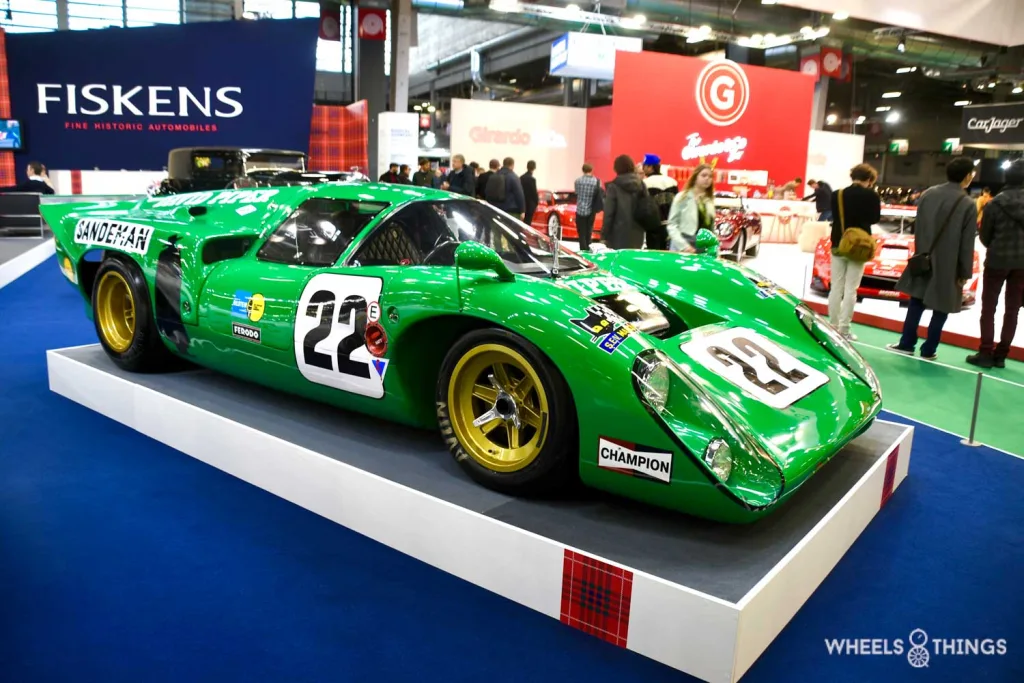
Piper’s green cars are very well known in endurance racing from the 1960s to the early 1970s. A Ferrari 250 GTO, 250 LM, 330 P2, 330 P4, 512M and also the Porsche 917 were part of his private racing stable. Most of his cars, with the exception of a red Ferrari 512 and a yellow Porsche 917 ran in the green colour. This originally came from a sponsorship deal with British oil company BP from which the green was adopted from the logo. BP was later replaced by Shell but the green had since become Piper’s trademark and its cars remained green.
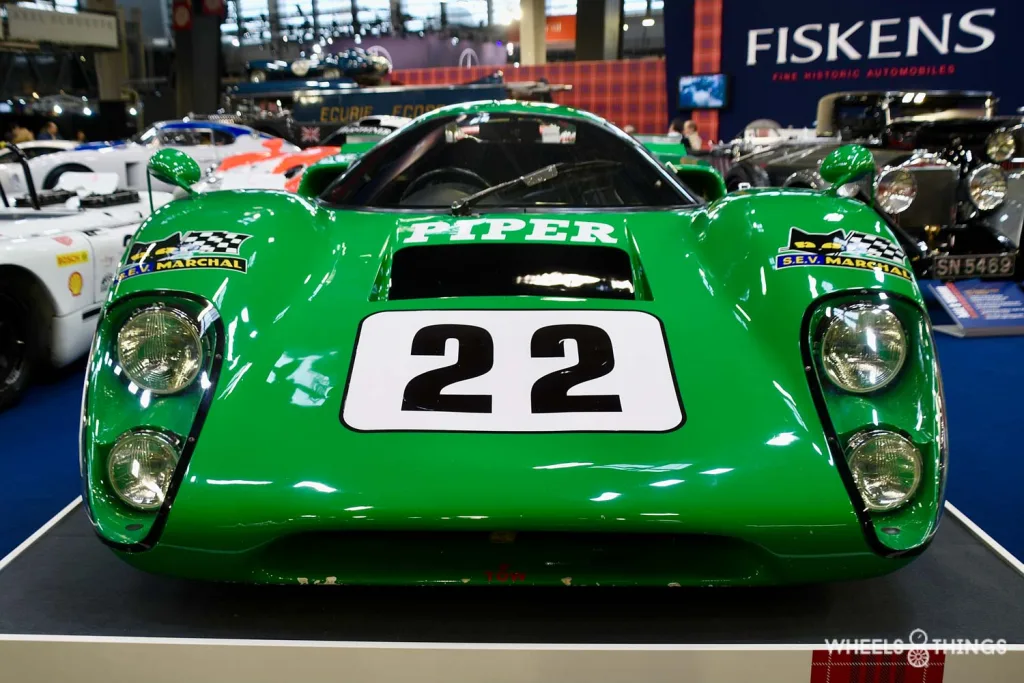
Besides the thoroughbreds from Maranello and Stuttgart, there was also this Lola T70. A car designed and built by Lola Cars for true private teams. The Piper team hovered between private and factory teams. This is an MK III B version of T70. This creation, with chassis number SL76/150, by Eric Broadley was equipped with a fat 5-litre Chevrolet V8 prepared by Traco. Besides David Piper himself, Richard Attwood, Jean-Pierre Beltoise and Hans Hermann were also behind the wheel of this Lola. Another T70, from the Penske team, won the 1969 24 Hours of Daytona.

The Piper Lola is mainly used in smaller races. There is a win in the Solitude race near Stuttgart. But it is mainly on French soil that this SL76/150 is quite successful with wins at Magny-Cours, Monthléry and Dijon in 1969. The following year, the Lola is loaned to Steve Mcqueen’s Solar Productions for filming of his film “Le Mans”. Thereafter, Piper sells the Lola.

As recently as 2017, we saw it pass by during the Masters Sports Car race at the Six Hours of Spa. The car was then fitted with a replica bodywork to avoid damage to the original. The original has now been fitted back on the car.
10. DOME S 101 – RACING FOR HOLLAND
Dome is a Japanese manufacturer of racing cars. The company saw the light of day in 1965. They mainly modified Honda cars. From 1975, they started building full-fledged race cars. Dome built prototypes, Formula 3, Formula 2 and even a test car of a Formula 1 car. Unfortunately, this project was halted due to a lack of pennies and engines that Mugen Honda would not supply.

At Ascott, we saw this Dome S 101 with chassis number 03 from 2002. This Dome competed in the 2002 24 Hours of Le Mans under the banner: “Racing for Holland” with a full Dutch line-up. Team boss Jan Lammers was assisted by Tom Coronel and Val Hillebrand. The team already had a previous model of Dome for the races in the ISRS ( International Sportscar Racing Series ), the predecessor of the Le Mans Series.

For sponsorship, companies could subscribe to a piece on the car’s bodywork. Thus, many small sponsors ( about 250 ) were still able to ensure that the required budget was met. It is a brand-new Dome that drives its first laps on the official test day in May. In the first qualifying sessions in June, Lammers delivers a stellar performance. He settles into third place with a time of 3’31″355, among the favoured Audi, Cadillac, Bentley and Panoz cars. In qualifying, Lammers does one second more and drops to P5. Still a fine result.

In the first hour of the race, Jantje Lammers gets involved in the battle for the lead. He actually climbs to P3 just before the first pit stop. But his co-pilots do not have the same experience and the Dome drops back in the standings. But notwithstanding several steering errors, the Dome climbs back into the top 10. At dawn on Sunday they are on P7 but after a slide by Cornonel they lose a few places again. Two hours before the end of the race, there is another unforeseen pit stop. There is smoke at the back of the car and the gearbox oil is still preventively changed.
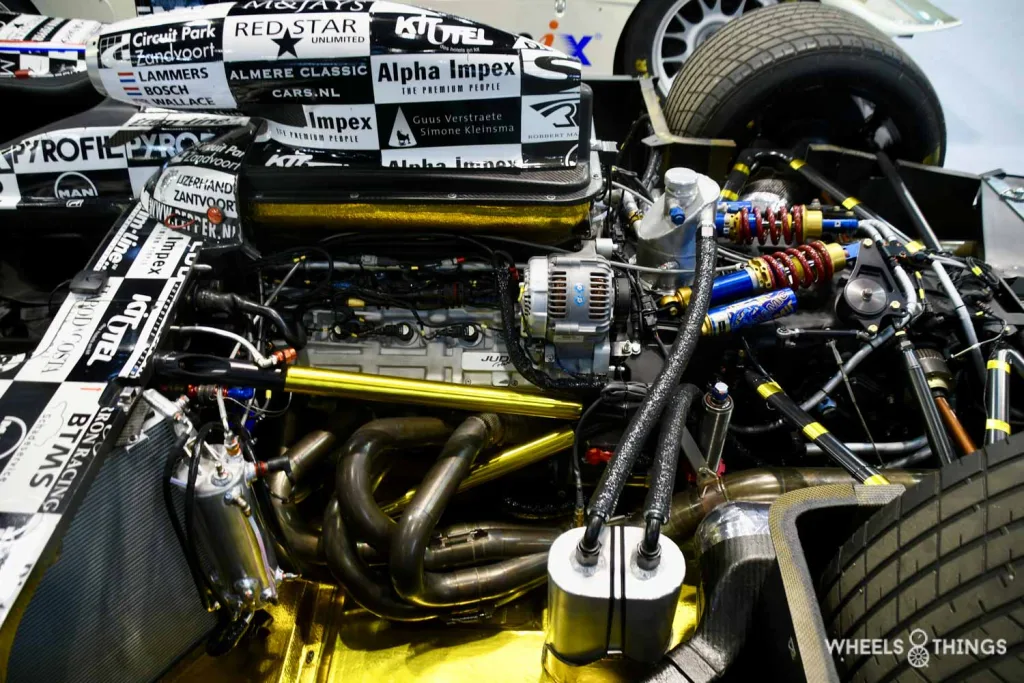
The gearbox holds up and Lammers/Coronel and Hillebrand finish in eighth place in the final standings with 24 laps behind the winning Audi of Kristensen/Pirro and Biela who walk away with the win for the third consecutive time. The Dome does finish ahead of the two official Cadillac Nothstart LMP cars. For an entirely private initiative, certainly not a bad result. With a top trio of drivers and a better budget, there would certainly have been much more. This S 101 has been signed up for the Peter Auto organisation’s Endurance Racing Legends in 2024. There it will undoubtedly cause a furore again.
Article and photos: Joris De Cock
